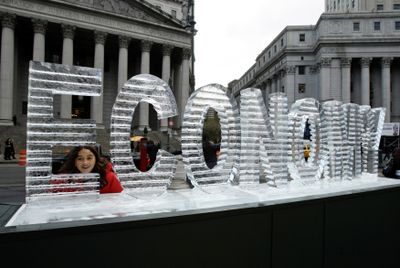Future hope, present gloom
Election boosts markets despite dismal reports

WASHINGTON – The financial world looked hopefully ahead Tuesday to a new president who will confront an economy beset by a stubborn housing slump and the worst financial crisis in 70 years, which has caused consumers and businesses to sharply reduce spending.
“He will inherit an economy that is in recession and … is likely to get worse before it gets better,” said Stuart Hoffman, chief economist for PNC Financial Services.
Still, investors seemed to draw hope Tuesday from the prospect of a new presidential administration, while shrugging off the latest in a series of grim economic reports. The Dow Jones industrial average surged more than 300 points. The Dow and other major stock indexes all finished with gains of more than 3 percent.
“Certainty is going to replace uncertainty,” said Ken Mayland, president of ClearView Economics, referring to the election results.
In another sign of the dismal economy, the Commerce Department said factory orders dropped 2.5 percent in September from August, more than three times as much as analysts had expected. Excluding autos and aircraft, orders fell 3.7 percent, the steepest drop since 1992, when the department began tracking sector-specific changes.
The weakness was led by a heavy drop in nondurable goods orders, which fell 5.5 percent. That included a 17 percent drop in the value of petroleum and coal products, reflecting the decline in oil and gas prices in September. Oil has fallen by more than half from its record level of $147 a barrel in July.
Analysts said the report wasn’t as bad as it looked, because much of the decline was driven by the drop in the value of oil and gas orders.
But orders for non-defense capital goods excluding aircraft, considered a good indication of business investment plans, fell 1.5 percent. That follows a 2.3 percent drop in August and indicated companies are cutting back on their investments.
“Corporate America is buying into the recession story, and they are paring their investment spending accordingly,” Mayland said.
The factory orders report came a day before the release of the widely watched Institute of Supply Management gauge of activity in the U.S. services sector – including hotels, retail, health care and mining – for October. That index is expected to fall, though not as steeply as its sister manufacturing index did Monday, when it dropped to its lowest level since the country’s last deep recession, the 1981-82 downturn.
Automakers also reported terrible October sales figures on Monday. Sales sank 45 percent at General Motors Corp., 30 percent at Ford Motor Co., 25 percent at Honda Motor Co. and 23 percent at Toyota Motor Corp.
The government reported last week that the overall economy, as measured by the gross domestic product, shrank at an annual rate of 0.3 percent in the July-September quarter. Two straight quarters of lower GDP generally mean a recession, and many economists expect the fourth quarter to be worse than the third.
Separately, the government, raising cash to pay for the array of financial rescue packages, said Monday it plans to borrow $550 billion in the last three months of this year. Treasury Department officials also projected the government would need to borrow $368 billion more in the first quarter of 2009, meaning the next president will confront an ocean of red ink.
The nonpartisan Committee for a Responsible Budget estimates all the government economic and rescue initiatives, starting with the $168 billion in stimulus checks issued earlier this year, total even more – an eye-popping $2.6 trillion.
Besides the borrowing numbers, Treasury released estimates by major Wall Street bond firms projecting that total borrowing for this budget year, which began Oct. 1, will total $1.4 trillion, nearly double the previous record.
Major Wall Street firms were equally pessimistic about the size of the federal deficit this year. They projected it will hit $988 billion for the current budget year, more than twice the record. In July, the administration projected a deficit for this year of $482 billion, but that was before the financial crisis erupted in September.
Supporters of the government rescue packages argue that the ultimate cost to taxpayers should end up being a lot smaller, partly because the Federal Reserve is extending loans to banks that should be paid back.